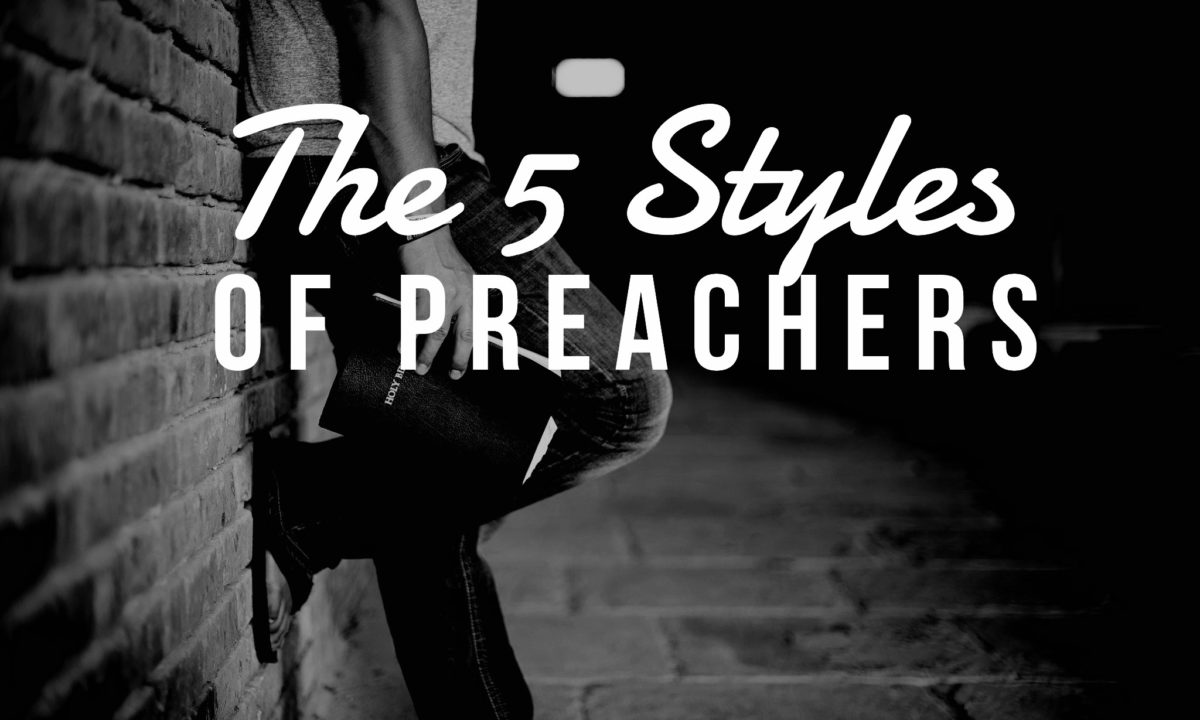4 kinds of Preaching Style
I will be teaching later in our School of Campus Ministry. I am excited to have a chance to speak to my fellow workers about a topic I am passionate about – preaching.

The Bible puts a high premium on preaching. 2 Tim 4:2 commands us to ministers to PREACH THE WORD.
There are 4 kinds of preaching style being commonly practiced in churches today and I am not an advocate of any style but I do advocate preachers to not bore people with the WORD.
The Bible is living and active – it convicts people of their sin and one of the gravest sin is sleeping during a sermon which means if as a pastor I bore people to sleep then I am part of the problem. Anyway here are the 4 styles of preaching.
1. Expository preaching – this is preaching through a book of the Bible verse by verse. I have never tried this but would really love to. Some of the pastors who use expository preaching are Mark Driscoll and Matt Chandler.
2. Textual preaching – this is how I usually preach. This style falls between expository and topical preaching. Churches that offer sermon series usually have this style of preaching. Textual preaching is preaching on a section of the Bible without preaching the entire book of the Bible.
3. Topical preaching – this preaching uses several Scriptures of the Bible to address an issue or discuss a topic. This is the most used style of preaching.
4. Narrative preaching – this style is gaining some grounds nowadays especially with the concept of storytelling being widely used in the business world today. I rarely use this style as some of the portions of the Bible are not narrative. The letters of Paul to the churches are not narratives. Example of books that are narrative are Ruth and Esther.
My suggestion is that as preachers of the Word we use different styles of preaching and not get stuck with one. We can not be legalistic on what we should use but be adaptable and open to what the Spirit leads as you prepare your messages.
what is your preaching style?
SOURCE: https://dennissy.com/4-kinds-of-preaching-style/
2.
Chapter Five
Impact, event, and context in contemporary preaching
5.1 Mapping the commonalities.
The diversity of the trends identified in the earlier review (sections 2.4 to 2.8) presents a particular challenge to the analysis of justifiable generalizations about homiletic theory and practice in the last half-century. As Edwards observes, ‘there seem to be more forms of preaching today than in all previous Christian centuries put together’ (2004: 835). Furthermore, Edwards judges that ‘preachers during the late-twentieth century tried to accomplish a greater variety of things through their sermons than any of their predecessors attempted’ (2004: 663). Allen, Blaisdell and Johnston similarly describe the current homiletical scene as a ‘smorgasboard of approaches’ and cite no less than eleven identifiable contemporary styles of preaching (1997: 171).
According to Edwards two developments account for this diversity: namely, the sheer number of people who designate themselves as Christians (in the 20th century Christianity became the most extensive and universal religion in history (Barratt, 2001: 3)), and the huge proliferation of organizational bodies within which preachers are operative (2004: 835). The work of the statisticians Barratt, Kurian and Johnson supports Edwards’ judgement; in their World Christian Encyclopedia (2001) they estimate that in the year 2000 Christians of all kinds numbered 2 billion people in 33,820 distinct denominations (2001: 10). They observe that ‘there are today Christians and organized Christian churches in every inhabited country on earth’ (2001: 3). The impact of this globalization is significant even in the much narrower geographical confines of this thesis, and it is inconceivable that an accurate appraisal of preaching practice and theory could be made apart from a ready acknowledgement of the forces and influences that are properly termed global. The indicators of institutional decline apparent in the churches of the Western world have to be set against rapid and continuing growth in other parts of the globe. This shift of numerical strength inevitably has consequences for preaching as for other aspects of church practice and faith. The presence in the UK of Christian personnel from the southern parts of the world, increased congregation to congregation contact made possible by cheap air travel, and the development of Internet usage, all offer new understandings and strategies from elsewhere in the global church in ways much more directly influential than even in the immediate past. The practice of preaching, like most other human endeavours in the early twenty-first century, takes place within a pluriform social environment in which many and diverse influences from the widest possible arenas of human activity have a bearing. That said, preaching, in social terms, remains predominantly a locally-focused activity, and sermon style and content are usually closely related to the specifics of the sub-cultural frames in which the life and self-understanding of the congregation is set. Consequently, the power of the local context is another factor underlying Edwards’ observation of the immense diversity of contemporary sermon styles. As Edwards puts it, such diversity shows ‘how radically ad hoc all Christian preaching is’ (2004: 835). That is not to say, however, that such enormous diversity denies the possibility of any sensible generalization. In particular, as was suggested in the earlier review, three aspects are identifiable within contemporary preaching practices that have particular significance for collective memory-namely, awareness of a sermon’s psychological engagement, communicative salience and contextual pertinence. In other words, those aspects of preaching that deal with a sermon’s impact on the hearer; its purposefulness as an event in its own terms; and its relationship to the context in which it is delivered and heard.
3.

The 5 Styles of Preachers—Which Are You?
- 41shares
- Share on Facebook
- Share on Twitter
If you wanted to write the great American novel, you’d probably read a lot of Hemmingway or Twain. If you wanted to be a great painter, you’d study the masterpieces of Rembrandt or Picasso.
And if you want to be a great preacher, it’s no different: you’ll study the masters.
As I continue to grow in my preaching ability, I have made a habit of listening to a wide variety of preachers. And I’ve noticed something. Although every preacher is different, each one tends to fit into one of five “preaching styles.”
We are all called to preach the Word (2 Timothy 4:2). The message should never change. But we all communicate the unchanging truth of Scripture through the filter of our personality.
Preaching, as Philips Brookes famously said, is “truth mediated through personality.” This is why five preachers could all preach the same truth from the same text, and each sermon is different. The message is the same, but the personality is not.
God’s Word always takes priority over your style. But understanding your preaching style will help you see how your God-given personality influences the way you communicate His Word. And when you know your style, you can leverage your strengths, and avoid potential pitfalls.
1. The Motivator

“God has a better plan for your life!”
The motivator is the preacher whose primary goal is to push their audience’s faith into action. They move from one point to another on stage with excitement, arms pumping, hands waving, reenacting every moment of a story. They love illustrations that tug on your heart and spur you to action.
After listening to the motivator, you are ready to charge the gates of Hell with a water pistol.
The common theme of the motivator is life change through Christ.
God has a better plan for your life. So keep going. Keep growing. Stop sinning. Don’t give up. Have faith. God will use you to change the world! The motivator points believers to the hope of the gospel, focusing on how God is at work within them to transform them into the image of His son.
The motivator has the innate ability to inspire their audience to action. They sincerely aim to follow James 1:22 in being “doers of the word, and not hearers only.”
The danger of the motivator is that they can easily fall into preaching a works-based righteousness. If so, people will begin to think that their standing before God is based more on what they do for God, not what God has already done for them.
If you are a motivator, use your contagious enthusiasm to inspire others. But make sure that you are leaning on the power of the gospel to motivate instead of an emotional frenzy to manipulate.
2. The Scholar

“Think about this with me.”
The scholar is a bookworm at heart. They love reading the classics and searching the wisdom of the intellectual giants of Christendom so that they might share their discoveries with the world.
They place a high emphasis on the amount of study they do to prepare a message. If not for other obligations, they could get lost in studying Scripture for days. Logos is their best friend.
The common theme of the scholar is the reason for faith in Christ.
Scholars present an intellectual approach to faith. Their sermons are well thought, organized, and logical. Skeptics of Christianity will find their messages intriguing, as their doubts and objections are acknowledged and answered.
The weakness of the scholar is the flip-side of their strength. If they are not careful, their message can become so intellectual that they leave the average person behind.
Scholars, use your intellect and thirst for knowledge to give others a taste of the depth of God’s Word, so we hunger for more. But don’t dive so deep into the details that you distract your audience in the facts and lose focus on the main point. You do not have to share everything you learn. Stay focused on what matters most.
3. The Evangelist

“Jesus is knocking at the door to your heart.”
The room is packed. The fiery preacher gives an impassioned gospel plea. The band comes out and plays a powerful song, and people are called to make a decision. “Come to the altar and give your life to Jesus!”
The evangelist ends every sermon with an altar call. Nothing excites them more than seeing people come to faith in Christ. Every sermon is a gospel presentation.
They are not afraid to talk about sin or hell. After all, their sermon may be the last warning someone listening ever gets. A staple of the evangelist is stories of life transformation. They love sharing the testimonies of people whose lives have been radically changed by Christ.
The common theme of the evangelist is winning people for Christ.
Their passion and dedication to evangelism often leads to people coming to faith in Jesus. And their churches often grow as more and more people are added to their number. However, all of this can come at a high cost.
The evangelist’s passion for evangelism may distract them from discipling new believers. If left unchecked, their churches can fill with baby Christians who are never discipled to grow in spiritual maturity. They must be careful to emphasize spiritual growth as much as conversion.
So if you are an evangelist preacher, use your evangelistic enthusiasm to reach as many as you can with the gospel. And build a team around you that works to ensure you’re fulfilling the Great Commission in making disciples, not just converts.
4. The Hipster

“I saw this Tweet the other day.”
The hipster is always up to date on current events and cultural trends. They love movies, music, social media, and the latest technology. They may even fit the stereotype of the pastor with a meticulously groomed beard who wears skinny jeans, and lumberjack shirts.
Their sermon series often play on a hit movie title or the hottest new app. But don’t let their trendy clothes or sermon titles fool you. They take incarnational ministry seriously.
Like Jesus, who left Heaven and became God in flesh, they want to live among the people. And like Jesus, who used agricultural illustrations to communicate His message to an agricultural society, they use the technology and trends of the modern world to point people to Christ.
They are motivated by a deep desire to reach a culture that finds Christianity irrelevant. Knowing and engaging in the culture of the city where they live is all part of their ministry and sermon preparation.
The common theme of the hipster is the relevance of Christ.
The hipster is gifted in applying God’s Word in a remarkably relevant message. Many people from an unchurched background or who have walked away from a traditional church will find their approach refreshing.
But, to their peril, the hipster can fall into the trap of focusing too much on being culturally relevant. This happens when their message comes more from culture than the Bible.
If you are a hipster preacher, always start your sermon preparation with God’s Word. Then, use your strength of taking timeless biblical truths and apply them to modern culture. If you focus on culture first, you will be tempted to twist the Bible to say what you want it to say, not what it actually says.
5. The Counselor

“We are all broken. There are no perfect people here.”
The counselor has a heart for broken people. Their sermons will touch on some of the deepest troubles of the human condition, such as depression, anxiety, addiction, suffering, and divorce.
They also love to preach preventative topical sermons, like how to find your purpose, strengthening your marriage, or raising spiritually healthy kids. Listening to the counselor preach makes you want to sigh in relief that you are not alone in your struggles.
The common theme of the counselor is the healing found in Christ.
The counselor sees the church as a hospital for the sick. Sin is the disease, and the cure is Christ. No matter what you have done or what has been done to you, there is forgiveness and healing at the cross.
The strength of the counselor is their heart for the broken. Many people are hurting and need the message of love, hope, and healing that the counselor offers.
But the weakness of the counselor is that they can focus too much on God’s grace for sinners, and neglect His commands for righteous living. They can drift into teaching antinomianism—becoming too soft on sin and failing to communicate that Christ calls us and empowers us to a better way of life.
Counselors need to ensure that they balance talk of pain and suffering with hope. Address the issue, but don’t dwell on the problem. Spend the majority of your sermon talking about the solution found in Christ and the higher standard of righteousness that he calls us to. Also, when appropriate, try to keep a healthy sense of humor about our issues.
What style preacher are you?
Maybe one of these perfectly describes your style. Maybe you are a mixture of a few.
If you don’t know which you are, just ask. Your congregation or your spouse will know right away.
They key is to know your style so you can leverage your strengths and—most importantly—avoid your pitfalls.
In short:
- Motivators – Never preach works without grace.
- Philosophers – Don’t get so lost in the details that we cannot follow.
- Evangelists – Make more than converts. Make disciples.
- Hipsters – Don’t distort Scripture for the sake of cultural relevance.
- Counselors – Identify the problem but focus on the solution.
We have seen far too many gifted preachers fall into these traps. Don’t allow your preaching style to derail the reason you preach—the edification of believers and the proclamation of the gospel of Jesus Christ.
/
4.
4 Types of Preachers: Which Style Are You?
Preaching has been the central element in most Protestant worship services for over 500 years. It’s the main thing pastors do, in terms of time consumption. Yet remarkably few pastors have a strong sense of identity as a preacher.
Not every pastor approaches the task of preaching in the same way. There are at least four distinct approaches to the pulpit.
Though there are many sermon forms, most preachers fall into one of these four categories, each with a different answer to the question “What are you trying to accomplish in the pulpit?”
The Homiletician
Generally, liturgical churches reserve less time in their worship and a less exalted place for the sermon (that belongs to the Eucharist). The pastor is never referred to as “the preacher” but is called a “priest.” Preachers in these traditions sometimes spend less time and energy on their sermons because they do not see it as the main thing they do. They are more like meditations or devotionals on the text, usually the Gospel text. A homiletician asks you to feel.
The Sermonic Essayist
Preachers in mainline denominations often take an intellectual approach to the sermon. Their sermons are really well-crafted essays based on the biblical text. The preacher usually reads the sermon without any attempt to cover up what he or she is doing, just like an academic reading at a university. While some Bible teachers and exhorters post their sermons online in audio or video form, essayists usually post their messages in manuscript form, complete with footnotes. An essayist asks you to think.
The Bible Teacher
Fundamentalist churches—I’m using that term as broadly as possible here—view the sermon as a Bible lesson. The pastor considers himself to be an “expositor” of the Bible or a “teacher.” Generally, the sermon is an exegetical essay, running commentary on the text with some insights for application. Chuck Swindoll may be today’s best known Bible teacher-preacher. A teacher wants you to understand.
The Exhorter
This is the type of preaching I was raised on. It’s popular in Pentecostal churches, holiness churches, and some others. The pastor is generally called “the preacher” and the sermon is the centerpiece of the worship service. In fact, we used to have two services in one. The first part of the service was called “the song service,” and the second part was called “the preaching service.” This type of preaching is a highly animated discourse based on the Scriptures that urges people to make some life change. An exhortation is typically followed by an altar call or some other response mechanism. Exhorting preachers always “preach for a decision.” An exhorter wants you to act.
Homileticians and Bible teachers are more likely to stick closely to the text, basing their sermon, even deriving their outline, from the structure of that single passage or even verse of the Bible. Essayists and exhorters are more likely to be free in their use of the Bible, drawing form “the whole story” to make their case.
Homileticians and Essayists are more likely to be found in liturgical or mainline churches (and preach shorter sermons), while Evangelicals, Pentecostals, and Holiness preachers are usually either Bible teachers or exhorters (and preach longer sermons).
Bible teachers seem to thrive on the radio, exhorters make great televangelists, and essayists often post their sermon manuscripts on line or publish them in book form.
Preaching has changed over the years, and these categories are harder to define than they once were. For example, Rob Bell is a new version of the sermonic essayist, delivering well-crafted messages packed with thought.
Andy Stanley is the new version of a Bible teacher (whereas his father, Charles Stanley, is a straight-up Bible teacher). He sits at a table and “just talks,” but he’s teaching the Bible. Pete Wilson might be called the new version of exhorter. Underneath the cool clothes and the video introduction is a call for change—with a direct invitation to do it.
My own preaching has been shaped by three factors: (1) my upbringing under some of the best old-school exhortative preaching ever from my Dad, Norman G. Wilson, (2) my indoctrination into expository preaching at Gordon-Conwell Theological Seminary, and (3) my own temperament and personality, which leans heavily toward the sermonic essay. The result? Other may judge more accurately, but I’d call myself a new-style exhorter or “exhortation light.”
What about you?
What type of preaching do you prefer? What kind of preacher are you?
5.
5 Types of Preaching
When preaching, I often try to measure up the listeners in the room. I want to know if they are engaged, bored, drowsy, or prepared for the time of worship and the Word. More often than not, my assessment should start with myself. As a pastor, I need to evaluate my own heart and preparedness for the moment of the sermon. In doing so, I’ve come up with five generalized styles of preaching: four of which need to be guarded against and one that I hope is the regular manner in which I preach.
1. Pulpitainment: In this manner, being clever replaces stating truth plainly. The truth is in there, but you have to listen for it in the punchline, the video clip, or the story told by the preacher. We all know it is necessary to keep the listeners engaged in what we are saying. The glitch is that we think the Scriptures will not do so and therefore we have to drum up something more interesting to hold their attention. The right staging, songs, illustrations, and all the rest can be parts of a great worship service… as long as it is pointed to worshiping God. Don’t give in to the temptation to entertain the audience and forget that the time is primarily for the mission of the King.
2. Pulpiteering: The preacher becomes the point of the sermon. It happens when humility gets replaced by your ego. It is not done on purpose (I hope). However, there are times when the preacher wants to “assert his authority” in such a way that proves he is the leader of the church. This boisterous, blustery preaching exalts the man and loses the gospel message.
3. Over-Sharing: I’ve written before about how excessive authenticity leads to awkwardness. The preacher must present himself as a real person with real struggles. Any hint of a plasticized life will ring hollow. But a little authenticity goes a long way. You must know your congregation and understand how much to share before it all becomes awkward for the listener. We must not allow our transparency to become the only thing people remember when they leave the service. Be genuine but don’t use transparency and/or confession as a way to leverage a response from people.
4. Exegete-Only: Exegesis is a necessary part of sermon preparation. However, Hebrew or Greek word studies should not replace teaching the text’s truth and application. The exegetical process is wonderful for preparation, but in a sermon, it is quickly sterilized information. Plus, spouting off about your knowledge regarding ancient languages and customs can be a breeding ground for intellectual pride. Additionally, no one really cares about the eighteen derivations of that Hebrew noun. Use the information to give clarity to people, but don’t let Bible background information drive your sermon.
5. Passage-Driven Exposition: The preacher’s work is to expose the truth about God in the Scriptures to people in desperate need of transformation. To do so, it requires engaging people with the power of the Bible. In fact, the preceding list of possible speaking styles can all be effective when subservient to the scriptural text and used with wisdom. The preacher should be engaging and not boring because the text is alive with the power of God. The preacher should speak with a commanding demeanor because the subject matter is the commanding power of the gospel. The sermon should have a confessional attitude because everyone from the preacher to the listener is coming under the authority of God. Exegetical work and other preparation should show up in the content of the sermon because the pastor takes the work seriously to study diligently for the moment of preaching.
In the end, I want to preach a Bible kind of message in a Bible kind of way. If it is a narrative passage, I preach the story. When it is prophetic, I raise my voice and declare the oracles of God. As I cross into the epistles, I teach the principles. But in all of the various genres of the Bible, we must never lose the sense that we are communicating eternal truth in their temporary place to people who need gospel transformation. To that end, I am determined to let the passage God unveils before me to drive both the content and the manner of my preaching.
Philip Nation is the adult ministry publishing director for LifeWay Christian Resources. Find out more on his blog.

Comments
Post a Comment